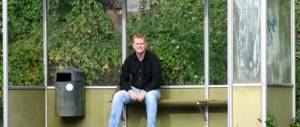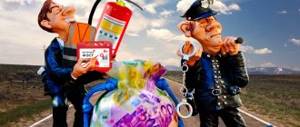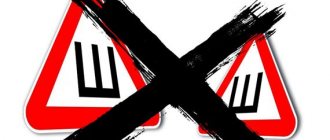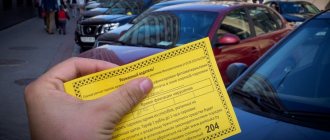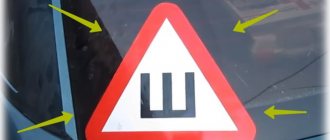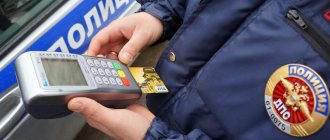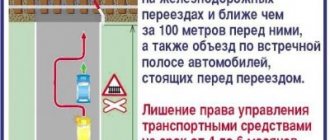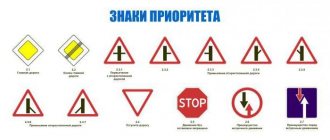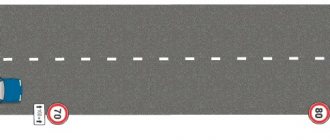A warning triangle is an indispensable attribute of any motorist, since traffic regulations prohibit vehicles that are not equipped with the appropriate sign from entering public roads. The warning triangle, or more correctly the “warning triangle,” has strict conditions of use and characteristics defined by law.
- 2 In what cases is it used
- 3 traffic rules
- 4 What to do if there is no sign
- 5 Fine for absence
What does a warning triangle look like?
The provisions of GOST 41.27–2001 apply to the emergency stop sign. According to the standard, the sign is a red equilateral triangle. Russian GOST is based on the provisions of UNECE rules No. 27.
When purchasing a sign in a store, it must be accompanied by instructions for use.
All such signs are produced uniformly and must have the following characteristics:
- size - side length 50 cm ± 5 cm;
- material - plastic or plastic;
- presence of a reflective strip of at least 50 mm;
- the presence of a fluorescent strip with a total area of at least 315 cm2;
- one of the sides must be equipped with a metal stand to stabilize the sign on the asphalt.
Both stripes are necessary to attract the attention of drivers: the reflective strip significantly increases the visibility of the sign in daytime conditions, and the fluorescent stripe in night conditions.
Transportation of the sign in the cabin or trunk of a car must be carried out exclusively in a case that protects the element from damage.
Is it possible to display a fire extinguisher and a first aid kit instead of a warning triangle?
According to current legislation, nothing can replace a warning triangle. Displaying a first aid kit and fire extinguisher does not serve a warning function for drivers of other vehicles: they cannot be seen in the dark or in inclement weather. Previously, the rules allowed the installation of a flashing red light, but since 2001 this exception has been abolished. The LED on the warning triangle was invented for good reason: it is what makes it stand out in difficult visibility conditions.
We recommend:
Towing a car to a parking lot: legislative framework, useful tips
In what cases is it used
The warning triangle must be at a certain height above the roadway surface
A warning triangle is used to attract the attention of other road users in cases where the car owner's car may pose a danger to them.
Such situations include:
- traffic accident;
- towing a car with a faulty warning light;
- forced car stop in unintended places on the road surface or in places with insufficient visibility.
Drivers moving in the opposite direction or in the same direction must be able to notice the warning triangle and take measures to safely pass through the emergency area.
Did the driver violate the Rules during a forced stop on the highway?
| 1. | Yes. |
| 2. | Yes, if you didn't put up a warning triangle. |
| 3. | No. |
The driver stopped due to a technical malfunction in accordance with the requirements of the Rules behind a solid marking line and turned on the hazard warning lights. Since he stopped on a highway where stopping is prohibited, he needs to place a warning triangle at a distance of at least 30 m from the vehicle. Otherwise, the driver will violate the Rules.
Traffic rules
The traffic rules approve the exact distance from the car to the stop sign, based on calculations of vehicle speed in various conditions:
- within populated areas, a warning triangle is installed at least 15 m before a vehicle in an emergency situation;
- outside populated areas, the sign is placed at least 30 m before the car.
The driver must not only comply with the provisions of the traffic rules when installing a sign, but also independently calculate the possibility of other road users noticing it. In conditions of reduced visibility (due to curves in the road, at night, in fog) or increased speed (for example, on a highway), the sign can be installed at a distance exceeding traffic regulations . It would not be superfluous to install a warning triangle 40 or 50 m outside the populated area.
When installing the warning triangle sign, you must wear a reflective vest
The warning sign must not pose an additional hazard to moving vehicles. For example, a sign placed after a sharp turn can provoke an additional accident - either with a stopped car or with the sign itself, which can be dangerous at high speeds.
A warning triangle near the stopping place does not replace the driver’s obligation to take other measures to notify road users of the current emergency situation. Thus, from 2021, drivers who make a forced stop in places not intended for this purpose due to an accident or traffic accident are required to wear a reflective vest.
When forced to stop in the wrong place, the driver’s sequence of actions should look like this:
- Turn on the hazard warning lights.
- Wear a reflective vest.
- Install the warning triangle at the required distance.
Each participant in an accident is required to display his own sign to warn other drivers. It does not matter how many cars were involved in the accident. Roughly speaking, if 10 cars collided in an accident, 10 warning triangles should be installed.
In some situations, a stopped car can pose a risk of accident to cars moving in both directions of the road. This can happen in an accident without other participants, for example, when a car turns around on the median. In this case, the car owner must warn traffic participants in both directions; therefore, he is obliged to install two signs in oncoming lanes. If this is not done, then the driver can be completely legally fined by the arriving traffic police officers. Therefore, we can recommend that any car owner carry two warning triangles in the trunk of the car at once - in rare cases this may be necessary.
Designation in case of an accident according to the rules
The traffic rules clearly indicate how participants in an accident should behave.
Thus, paragraph 7.2 of the traffic rules states that in the event of an accident the driver must:
- turn on the hazard warning lights;
- immediately display a warning triangle.
According to this clause, every driver who is involved in a traffic accident must display his or her own stop sign at the time of the traffic accident.
Experts and traffic police officers believe that the number of signal structures indicating an accident should be equal to the number of participants in the accident! If two cars collided, then there are two signs, and if there are three cars, then, accordingly, there are three.
In case of accidents where several cars collided with each other, in one lane it is necessary to set the number of cones equal to the number of participants in the collision.
The same paragraph 7.2 of the traffic rules explains the reason for the need to set an emergency stop mark.
This is to ensure timely warning to drivers of other vehicles about danger. A certain beacon that stands out from the general background, informing about an obstacle in the path of the car. Therefore, a sign indicating an incident on the road should be placed in the direction of movement of vehicles on this section of the road.
If cars collide on a one-way road or on the same lane, then stop signs in case of an accident can be placed nearby, no matter how paradoxical it may sound.
The rules determine the distance from the car to the location of the traffic accident.
They are hiding something...
There are two options:
- in populated areas - at least 15 m;
- outside populated areas – at least 30 m.
As you can see, only the minimum distance from the vehicle to the road signal is limited. There are no restrictions in the direction of the maximum distance between the signal triangle and the car. According to experts, this is a very correct decision.
After all, the permissible traffic rules and speed limits on the roads are taken into account. On highways and highways, cars move at higher speeds than in populated areas. According to the rules, the distance from the car involved in an accident to the marking point outside populated areas is doubled (30 = 15X2).
If you are involved in an accident on a section of the highway where cars are moving at very high speeds, you can move the warning triangles away from the scene of the accident to a distance exceeding 30 m. Such actions of yours will not be considered by the traffic police to be a traffic violation.
The emergency cone or fluorescent triangles are positioned to most effectively communicate the danger that lies ahead. For example, before a turn, not at a turn; on an elevation, and not on the descent from it, etc.
What to do if there is no sign
The only recommendation for drivers who do not have a warning triangle included in their car is to immediately purchase one. Previously, drivers were allowed to use a red light instead of a sign, but modern traffic regulations have abolished this provision.
The warning triangle and its stop must not have sharp edges or corners
If the warning triangle is still not in the trunk of the car, the driver should take all measures to warn other road users about the emergency. To do this, you can use any available objects that will help attract attention and warn other participants about the danger that threatens them. In practice, such a means can be a bucket, a fire extinguisher, a first aid kit, bright clothes, etc. Of course, such an action will not help avoid a fine for the absence of a warning triangle - as soon as traffic police officers arrive at the scene of the accident, they will issue a decree. But stopping such a warning sign will help prevent an additional accident that threatens the health and property of both the driver and other road users.
Distance from emergency sign to car
Sign Place of bus, trolleybus, tram and taxi stop In this
The distance to the vehicle depends on where the vehicle stops. In a populated area, this distance cannot be less than 15 meters, outside the city limits - at least 30 meters, as determined by clause 7.2 of the traffic rules. However, the same paragraph indicated that the distance must be sufficient so that other road users are promptly warned of the danger and can make the necessary maneuver. So, depending on the situation, the following rules are used:
- If a vehicle is stopped just after a sharp curve, the sign must be placed in front of it.
- If the vehicle has stopped behind a hillock, the sign is placed in front of it.
- If the stop occurs on a highway, an emergency sign is posted at a distance of 50–100 meters so that other drivers have time to slow down if necessary.
- If an accident occurs at an intersection, the driver places a sign in the direction of the busiest traffic.
